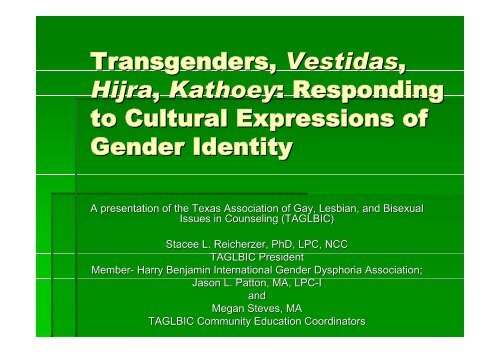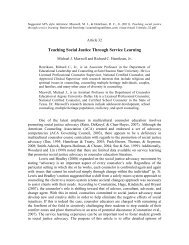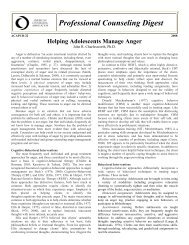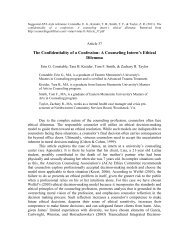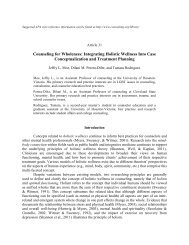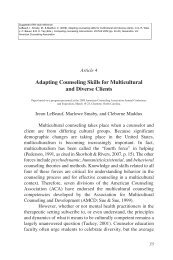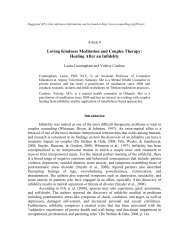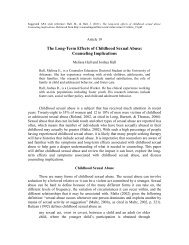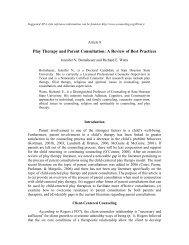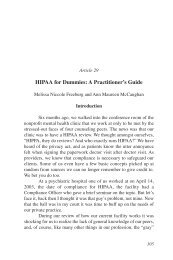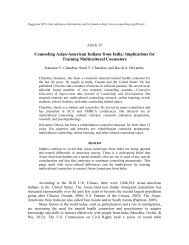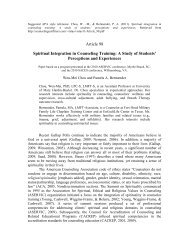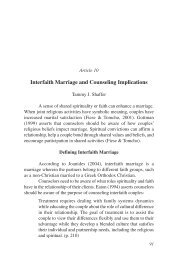Transgenders, Vestidas, Hijra, Kathoey - Counselingoutfitters.com
Transgenders, Vestidas, Hijra, Kathoey - Counselingoutfitters.com
Transgenders, Vestidas, Hijra, Kathoey - Counselingoutfitters.com
Create successful ePaper yourself
Turn your PDF publications into a flip-book with our unique Google optimized e-Paper software.
It is important to note…that sexual and genderidentities that are not accepted by Westerncivilization are not necessarily unnatural….humansocieties exhibit a wide range of norms and beliefsabout what natural sexual or gender identities maybe and be about. Forms of sexuality considered tobe perverse by one social or cultural group areconsidered to be right, good, useful and natural byothers and can indeed serve useful purposes (i.e.,enhance survival and well-being.)Stephanie Wickstrom (2005): The Politics ofForbidden Liasons
A Western Postmodern model ofsex and gender• Birth Assigned Gender- a person’s s apparent biologicalsex as assigned at birth. In the U.S., birth-assignmentis traditionally made by the doctor or midwife whoperforms delivery.Male __Female __• Sex- The genitalia a person has. This may be male,female, or a blending of the two. It is demonstrated asa continuum of bodily possibilities.Male I-------------------------------------------I-------------------------------------------II FemaleAdapted from Whalley (2005)
A Western Postmodern Model ofSex and Gender• Gender Identity- A person’s s core sense of being male, female,or a gender that is in-between or both. This is treated as acontinuum of identity possibilities, which may either fluid orfixed.Male I-------------------------------------------I-------------------------------------------II Female• Gender Expression- External characteristics and behaviors thatare socially constructed as either male or female: clothing style,demeanor, speech patterns, etc. These are treated ashistorically-based, and mobile over time based on culturalconsiderations of masculinity or femininity. This also isrepresented as a continuum of possibilities.Masculine I------------------------------------I------------------------------------II FeminineAdapted from Whalley (2005)
A Western Postmodern Model ofSex and Gender• An alternate way of understanding gender identity andexpression: Non-Mutually Exclusive Gender, expressedas a Dual Continuum. Maleness and masculinity is nottreated as opposite from femaleness or femininity. Ratherthese appear as equal possibilities that can beexperienced in a fuller range of gender possibilities, inwhich an individual identifies multiple characteristics ofeach gender; or alternatively, few characteristics.Male/Masculine 0--------------------------0--------------------------IFemale/Feminine 0--------------------------0--------------------------I
A Western Postmodern Model ofSex and Gender• Sexual orientation- The sex or sexes to whom a persontends to be sexually and otherwise relationally attracted.Sexual orientation maintains a variety of experiencesrelated to body-type attraction, relational dynamics inwhich romantic feelings occur, and other forms ofexperience that bring people into relational-sexualconnection. It is treated as a separate but parallelcontinuum from the gender continua.I-------------------------------------------------------------IMale AttractionFemale Attraction
Transgender Issues:Contemporary US Culture• The medical model of Gender Identity Disorder(APA, 2001), and transsexualism (Benjamin,1966) have been the dominant models used fordescribing experiences about transpeople bythe medical <strong>com</strong>munity• Beginning in the 1990s, the term “transgender”(Feinberg, 1996, 1998) came to be used as aself-description by transgenders who used apostmodern reframe of the medical model
The historical development towardstandardized care for transgenders(Reicherzer,, 2006)• 1920s: first sexual reassignment surgeries(SRS) performed in London on two“transvestite homosexuals.”• 1920s to 30s: Magnus Hirschfield’s s Institute ofSexual Science in Berlin• 1947: David Cauldwell coins term “transsexual”• 1952: George Jorgensen be<strong>com</strong>es Christine
The historical development towardstandardized care for transgenders(Reicherzer,, 2006)• 1962- UCLA opens the Gender IdentityResearch Clinic- endeavored to teach genderconformity to children• 1966- Harry Benjamin published TheTranssexual Phenomenon• 1966- Johns Hopkins University beganproviding SRS, first of many gender clinics todo so (each with its own standards)
The historical development towardstandardized care for transgenders(Reicherzer,, 2006)• 1968- The DSM II is published to include“Transvestism” and “Sexual OrientationDisturbance [Homosexuality]”• 1979- Harry Benjamin organized first HarryBenjamin International Gender DysphoriaAssociation (HBIGDA)• 1980- DSM III includes in “PsychosexualDisorders” a section of “Gender IdentityDisorders,” uses psychodynamic language indescribing how the experience ‘seems alwaysto develop in the context of a disturbed parent-child relationship ...” (p. 263).
The historical development towardstandardized care for transgenders(Reicherzer,, 2006)• 1987- DSM III-R, Gender Identity Disorders are now in a categorycalled “Disorders Usually First Evident in Infancy, Childhood, orAdolescence”- “weak reinforcement behavior” (p. 73) by parents isseen as a predisposing factor• 1970s to 80s- many private surgeons begin providing SRS.• 1994- DSM IV removes predisposing factors, several differentialdiagnoses• 2000- DSM-IVIV-TR modifies language once more, terms“autogynephilia” in describing MTF sexual preoccupation• 2006- HBIGDA changes its name to the World ProfessionalAssociation of Transgender Health (WPATH)
The Diagnosis: Gender IdentityDisorder (APA, 2000)- “Strong and persistent cross-gender identification”- “Persistent dis<strong>com</strong>fort with his or her sex or sense ofinappropriateness in the gender role of that sex”- Does not include physical intersex condition- “The disturbance causes clinically significant distressor impairment in social, occupational, or otherimportant areas of functioning”
World Professional Association ofTransgender Health (WPATH)Standards of Care (SOC)• Standards of Care provide re<strong>com</strong>mendedtransgender medical and mental health care• Epidemiological Considerations• Diagnostic nomenclature, which now usesDSM-IVIV-TR language• The role of mental health professional• Work with transgender children andadolescents• Work with transgender adults
Understanding WPATHStandards of Care• Mental health guidelines for medicalre<strong>com</strong>mendations for hormone replacementtherapy• Medical effects of hormones• Require a real-life life experience of one year priorto surgery• Guidelines to determine readiness for genitalSurgery, breast surgery• Post- Transition Follow-up
Important Considerations• Both the medical model of Gender IdentityDisorder and the Postmodern model of Genderand Sexuality represent Western paradigms• A number of expressions of gender identityhave existed in other cultures, throughouthuman history• Global expressions of gender identity havebeen impacted, at varying degrees, by Westerncolonizing of aboriginal culture and thought
European and UnitedStates World Conquest• Colonization• Forced adherence of aboriginal cultures todominant European ideologies, includingsystem of gender binarism• Eradication of native cultures, religions,systems of beliefs• This has led, in many instances, to thedomination of White-oriented capitalist cultureover indigenous cultures
Consideration ofColonization• What is colonization?• The imposition of one culture’s s worldview onanother• The imposition of one system of language asa means of organizing the universe• Erasure of other cultures’ traditions, speech<strong>com</strong>munities
Three Global Expressions ofMale-FemaleIdentities• <strong>Vestidas</strong> of Mexico and the U.S. Border Region• <strong>Hijra</strong> of India• <strong>Kathoey</strong> of Thailand• Important research limitations:• These groups’ experiences have been only minimally explored byanthropologists, even less by mental health professionals- limiteddata for each group• Most of the previous research and historical accounts have beencollected by researchers from outside the group, and reflects theresearchers’ biases about sex and gender• The three researchers of this work are White counselors, Queer-identified, who live in south central Texas- outside of these threecultures
<strong>Vestidas</strong> of Mexico andthe U.S. Border Region• Who are vestidas?• Gender and Sexuality in Pre-Hispanic Mexico andtoday• Influential factors• How vestidas view gender and sexuality• Living as a vestida
Who are vestidas?• Male born• Live as women, or simply identify as vestida (the Spanish word for“dressed”)• Very sexualized gender roles that are considered effeminate: highheels, short skirts, heavy make-up (Prieur(Prieur, , 1996).• <strong>Vestidas</strong> gender identities are closely linked to sex roles: they tendto be exclusively male-attracted, attracted, and generally prefer to bepenetrated in anal sex (vestidas(do not generally prefer topenetrate). This is thought to be consistent with a female role(Thing, 2004).• While difficult to trace precisely, the history of vestidas may berooted in pre-Colonial Mexico (Carillo(Carillo, , 1999)
Fluid Gender and Sexuality inPre-Colonial Mexico• Difficult to trace due to author bias- many historicaldocuments were written by Spanish conquistadoresand missionaries, who used derogatory language todescribe Native traditions• Ritualized and Institutionalized sexual practices,gender blending were practiced by Mayans and somenative cultures in Central Mexico (Carrillo, 1999;Castaneda, Brindis, , & Castaneda-CameyCamey, , 2001).• Many practices were linked to healing and deities• Xochihua- Nahuatl word of reverence for people ofblended genders (Sigals(Sigals, , 2005)
Current Mexican Attitudesabout Gender and SexualBlending• Machismo (Carrillo, 1999; Castaneda, 2001) reflects amale attitude of demonstrable masculinity, according toMexican social norms. Traditionally, machismo is not<strong>com</strong>promised in sex with another male, so long as themacho male does not play a feminine sex role (is notpenetrated anally by another male.) So long as a maleis penetrating, he retains machismo.
Outside Influences• U.S. culture, English language has significantinfluence on Mexico• More affluent Mexicans, Mexican-Americanswho have access to higher educationresources have adapted U.S.-EnglishEnglish-basedunderstandings of gender and sexuality• Traditional understandings of sex and genderare more <strong>com</strong>mon for people who have hadless exposure to the U.S. culture (Prieur(Prieur, , 1996;Thing, 2004)
Cultural Considerations ofMexican-American Gender/SexualDiversity•Degree of saturation in English-based linguisticunderstandings of gender and sex•Degree of colonization, exposure to Eurocentricvalues (oftentimes driven by higher SES)•Linguistic differences, terminology varying by regionof Mexican or Mexican-American origin•Cultural differences varying by region (Mayanregions, for example, continue to recognize thirdgender.)•Age
How vestidas view genderand sexuality• Homosexual/PasivoPasivo- A natal male, whose maleattraction forms a gender identity marker; primarily (orexclusively) performing oral sex, or receiving anal sexfrom a male Activo. . Is understood as female-genderedsexual orientation.• Vestida- A natal male, Pasivo, , who dresses in femmeattire some or all of the time, and often has bodilyaugmentation (black market silicone, peanut oil,mineral oil).• Joto, Maricon, Puto- Generally, derogatory slurs forPasivos, <strong>Vestidas</strong>; a slightly different connotation thanthe English word “fag. fag.”
How vestidas view genderand sexuality• Activo, Mayate, Chichifo, Picador- A natal male, whose genderidentity is seen as macho male, who exclusively performspenetration on a pasivo. . In this model, because he is neverpenetrated, he is not considered homosexual (and is not generallyreferred to as joto, maricon, , etc.) Activos often maintain theirprimary romantic relationships with natal females.• Bisexual- Generally, a male who performs both penetrates, and ispenetrated by another male.
Living as a Vestida (Prieur,1999)• Few economic opportunities- many work as hairdressers or prostitutes• Emphasis in cultural norms of beauty, grace• Emphasis in sexual desirability to mayates• La familia, reverence to one’s s mothers remains an important part of theperson’s s life• <strong>Vestidas</strong> often live in close <strong>com</strong>munities, share living space with othervestidas• <strong>Vestidas</strong> in their societies may be called names or slurs, but overall, thereis a degree of cultural acceptance (vestidas(who were interviewedconsistently stated that they had never been the victims of physicalviolence because of their gender)
The Lives of <strong>Hijra</strong>s ofIndia• Historical Perspective• Effects of Colonization• Roles in Society• Media Representations• Author Bias• Looking Towards Tomorrow
Historical Perspective• Born male sex-type (with male genitalia)• Defined as “neither man nor woman”• Many experience gender identity as “like women”• “Origin myth” explains caste’s s origin by linking caste toHindu deities• Deity Ram blessed those “who were not men and notwomen”• Alternative gender roles of deities and mythic figurescreate positive identity for hijras• Member of traditional social organization who worshipgoddess Bahuchara Mata• Population in north approx. 50,000 (Nanda, 1990)
Historical Perspective(Nanda, 1990)• Born “Besarm” or without shame• Intimidation arises from fear of conveyanceof shame on non-hijras• Emasculation Ritual• Secret ritual removal of genitals• Sanctions role as performers; links to Shiva andMother Goddess
Effects of Colonization• British believed that homology betweensexual and political dominance fundamental• Redefined construction of power and subjectivity• Virile (British) masculinity legitimized colonizationover (Indian) femininity (Reddy, 2003)
Effects of Colonization(Reddy, 2003)• At turn of the century Indian nationalistsconstruct a new masculinity• Based on spiritual not bodily, physical strength• Ghandi calls for “dissident androgyny”• Ability to transcend male/female dichotomy• “God’ss Eunuch” both feminine and masculine• Sexual renunciation central to transformation intopowerful figure
Roles in Society(Nanda, 1990)• Roles in Society• Embrace the Mother Goddess identity; fertility• Traditional occupation as performer on auspicious occasions• Perform as dancers at weddings and births• Can give power to create new life to male child• After marriage ceremony blesses husband’s s fertility• Ritual reinforced by fear of shaming or curse of infertility to thosethat do not allow performance/offer money• Sex trade has be<strong>com</strong>e practical occupation• Prostitution• May also take “husbands”
Media Representations:Cinema (Chawda(Chawda, , 1997)• India represents the most liberal South Asian cinema• Concept of defending a “lifestyle” in cinema non-existent• Pre-9090’ss depictions:• Homophobic, drag roles, background entertainers• Seen as <strong>com</strong>ic relief or self-loathing loathing presence• At best supporting actors• Mid to Late 90s• Emergence as integral characters• Challenge conventional roles using characters in ordinary,human settings• Mani Rathnam’s Bombay, Mahesh Bhatt’s Tamanna• Gang leaders, Heros, Pimps
Media Representations:Literature (Vanita(Vanita, , 1997)• Traditional non-victim narratives and “optingout” of heterosexual structures• Bhakati Movement in India's medieval era(eleventh–eighteenth eighteenth centuries)• Populist literary form <strong>com</strong>posed by poet-saints of all castesand both genders• Criticized caste, class, religious differences• Men and women refused to be good spouses and parents• Altered gender categories by stripping them of meaning“Suppose you cut a a tall bamboo in two; make the bottom piecea woman, the head-piece a man; rub them together until theykindle: tell me now the fire that’s s born, is it male or female, ORamahathapoetRamahatha?” (Twelfth century Kannada Virashiva poetDasimayya)
Media Representations:Literature (Vanita(Vanita, , 1997)• Contemporary Authors• Narrative of power and creativity• Use of animals blurs boundaries of race, gender,culture• Suniti Namojoshi chooses beastly persona not inherentlyinferior to human; same spirit reincarnated as human andnon-human bodies• Vikram Seth draws on old tradition of friendship betweenhuman and non-human animals• Question of “she” or “he” meaningless by way of speciessameness and difference to mask (i.e. are two mice bothfemale? are the elephant and mouse both male? )
Author Bias• Serena Nanda Neither Man nor Woman• Cited as prominent study of hijras• Indian author’s s claims of openness to genderexpression questionable• Use of pejorative or shaming language• Described as, “ [individuals who seem] bizarre”• In describing performance: “twirled in a grotesque,sexually suggestive parody”
Author Bias• Anne Ogborn’s Saheli!• American transgender woman adopted hijraidentity through cultural immersion• Attempts to equate hijras with U.S. expression oftransgender identity• Ignores different context, cultural meanings• India’s “third gender” society seen as primordial;foundation of Western gender formulation (Towle(&Morgan, 2002)
Looking TowardsTomorrow• Political gains• New emerging force in Indian politics in 90’s• Elected at local, state and national levels• Revolt against upper-caste politicians• Seen as “Neutralists” who rise above nepotism & fighting typicalof men & women• More sensitive to issues of poverty and social stigma• Popular campaign slogan “You don't need genitals for politics;you need brains and integrity.” (Reddy, 2003)
<strong>Kathoey</strong> of Thailand• Traditionally male born• Portray themselves as women and live, in manyways, like them. Here, <strong>Kathoey</strong>’s views on genderand what it means to be a woman are much likethey are in the West (Winter & Udomsak, , 2002).• They do not hold status as women, however, theyare seen as phet thi-samsam: : the third sex (Totman(Totman,2003).• Some <strong>Kathoey</strong> prefer to be called sao praphetsong or phuying prahphet sam: : a second kind ofwoman (Winter, 2006).
The Place of <strong>Kathoey</strong> inThai Society• There are somewhat conflicting ideas on the history of <strong>Kathoey</strong>• Some believe <strong>Kathoey</strong> was originally used to describehermaphrodites [sic] (Jackson, 1998)• Others believe <strong>Kathoey</strong> has described transgender malesfor centuries (Totman(Totman, , 2003)• In Thai Buddhist belief systems, <strong>Kathoey</strong> are reincarnatedpeople who, in previous lives performed some acts of sexualperversity [sic]. Through kamma or karmic consequences, asoul is born to the life of a <strong>Kathoey</strong>. . Thai people are tolerantand/or kind to <strong>Kathoey</strong> because there is a widespread beliefthat all souls will be <strong>Kathoey</strong> at some point (Totman(Totman, , 2003).
The Place of <strong>Kathoey</strong> inThai Society• <strong>Kathoey</strong> believe society and their family membershold favorable attitudes towards them (Winter, 2006).• In contrast to this, many in Thai society see the roleof a <strong>Kathoey</strong> as one of suffering: where they arepitied because it is believed they will not find truelove and will be tormented by wanting and not beingable to have children (Totman(Totman, , 2003).• There is some social opprobrium based on theirfemininity and sexual passivity, rather than perceivedhomosexuality, though (CPAmedia(CPAmedia, , 2002).
The Place of <strong>Kathoey</strong> inThai Society• <strong>Kathoey</strong> can be found in many levels of society and theroles they fill vary accordingly (CPAmedia(CPAmedia, , 2002).• For centuries, <strong>Kathoey</strong> lived primarily in rural areas, buthave more recently moved to find work in the morepopulous cities of Phuket, , Bangkok, Chiang Mai, andothers (Totman(Totman, , 2003).• Still many live in smaller villages where they are visibleperformers as female impersonators in likay folk operasor in “transvetitebeauty contests” (CPAmedia,, 2002).
The Place of <strong>Kathoey</strong> inThai Society• <strong>Kathoey</strong>s exist in upper echelon roles asbusinesspersons, actresses, etc (CPA media,2002). However, the changing face of Thaisociety is be<strong>com</strong>ing less tolerant of <strong>Kathoey</strong>visibility to the outside world (Totman(Totman, , 2003).• <strong>Kathoey</strong>s are often performers in larger citieswhere they do performances which can belikened to drag in the west. They often arehired as greeters and serve fixed roles in barsand clubs (Totman,, 2003).
<strong>Kathoey</strong>s Working in theEntertainment Industry• Bars pay greeters, wait staff, and performers very little. Asa result, small <strong>com</strong>munities of <strong>Kathoey</strong> will support eachother while trying to earn money for themselves and to sendhome to their families.• There may often be a natural progression from being hiredas a greeter in a bar to personal entertainment, which oftenincludes some form of prostitution. Such personalendeavors are often encouraged by employers.• Tips received make up the bulk of the in<strong>com</strong>e of a <strong>Kathoey</strong>entertainer. Most <strong>Kathoey</strong> in the entertainment industrybelieve tips are directly related to beauty and femininity.• <strong>Kathoey</strong> who make the most tips experience a mixedreaction from their peers. These reactions run the gamutfrom envy to sabotage.(Totman,, 2003)
The Life of a <strong>Kathoey</strong>• <strong>Kathoey</strong>s often <strong>com</strong>e to a realization that theywant to live life as a phuying prahphet sam,second kind of woman, very early in life. Many telltheir families as preteens that they wish to be<strong>com</strong>e<strong>Kathoey</strong> (Totman,, 2003).• Nun Udomsak, , a Thai transgender researcher,relays her personal experience as beginninghormones, which are available over-thethe-counter inThailand, at 13 (Udomsak(Udomsak, , 2002).• Often, it is the goal of a <strong>Kathoey</strong> to earn enoughmoney to <strong>com</strong>plete Sexual Reassignment Surgery(Totman,, 2003).
The Struggle of <strong>Kathoey</strong>for Rights and Recognition• Totman (2003) describes the government of Thailand astrying to downplay the role of <strong>Kathoey</strong> in Thai life. In asense, this is to promote a more “cosmopolitan,cosmopolitan,” andessentially westernized image.• Udomsak (2002) believes the Thai people as a whole donot want <strong>Kathoey</strong> in jobs, like tour guides, visible to theoutside because “they give an unfavorable image ofThailand.” Because of this, people like Udomsak withuniversity degrees are having increasingly more troubleobtaining a “respectable occupation.”
The Struggle of <strong>Kathoey</strong>for Rights and Recognition• However, gender cannot be changed on any Thailegal documents even Sexual ReassignmentSurgery• There is no enumerated legal protection fromdiscrimination for <strong>Kathoey</strong>• Organizations for the promotion of <strong>Kathoey</strong> rights,like Si Chompoo, , are working towards legal andsocial change• Thailand is reported as having a RED (Respect,Equality, and Dignity) score for transgender peopleof 6/20.(Transgender rights: Thailand and the rest of the world<strong>com</strong>pared)
Global Gender DiversityRedefines Care Guidelines• Reconceptualizing:• Rethinking gender, movement from a disease model• Not to be seen as “sick, sick,” “crazy,” or “aberrant”• Moving beyond gender as a binary experience ofmale or female• Understanding that high functioning gender blendedpeople have existed throughout history
Global Gender DiversityRedefines Care Guidelines• Understanding social pain:• Consider that pathologizing gender diversityas a disease creates stigmatization andmarginalization• Consider the contextual features of what isconsidered mental illness• Understand the role of social reaction togender diversity in a gender binary culture
Global Gender DiversityRedefines Care Guidelines• Owning the profession’s s role in stigmatization• Understand the bias that informs the system ofdiagnosis for GID• Understand that the APA, in developing thediagnosis of GID, functions to reinforce societalbiases• This reinforcement feeds mistrust that many genderblended people feel about the mental healthprofession
Global Gender DiversityRedefines Care Guidelines• The helping relationship• Gender blended peoples’ expectations of mentalhealth are informed by prior experiences, as well asrelational images of professionals as representativeof a White, biased culture• Differences exist in the reasons gender-blendedpeople seek therapy, which inform expectations• Therapists function to support client’s s naming oftheir gender experiences, we do not do it for them
Global Gender DiversityRedefines Care Guidelines• Therapists as resources:• Therapists should not expect clients to teach themeverything about gender• Therapists educate other therapists, teachers, lawenforcement, and doctors• Therapists know <strong>com</strong>munity resources that arehelpful to gender-blended persons, includingfamiliarity with ethnic <strong>com</strong>munity resources
Global Gender DiversityRedefines Care Guidelines• Therapists as resources:• Therapists know WPATH SOC• Therapists assure that doctor referrals arecredible• Therapists advocate for equality in allexpressions of gender
Global Gender DiversityRedefines Care Guidelines• The person of the therapist:• The therapist is honest about personal values, ownbiases without “playingheadgames”• The therapist sees the gender client’s s humanness,not just the person’s s gender• The therapist shares with the client the therapist’smodel of gender, how the therapist conceptualizes it
Global Gender DiversityRedefines Care Guidelines• The person of the therapist:• The therapist is active in learning about genderissues, and demonstrates care through actions• The therapist and the client talk frankly about theirrelationship in a power structure that is establishedby WPATH SOC, and the need for therapist asdiagnostician of GID, for clients who seek SRS
References• Akerlund, , M. (2000). Teaching Beyond the Deficit Model: Gayand Lesbian Issues Among African Americans, Latinos, andGay Asian Americans. . Journal of Social Work Education.Spring/Summer 2000, Vol.36 Issue 2.• American Psychiatric Association. (1968). Diagnostic andstatistical manual of mental disorders (2nd ed.).Washington, DC: Author.• American Psychiatric Association. (1980). Diagnostic andstatistical manual of mental disorders (3rd ed.).Washington, DC: Author.• American Psychiatric Association. (1987). Diagnostic andstatistical manual of mental disorders (3rd ed., Revision).Washington, DC: Author.• American Psychiatric Association. (1994). Diagnostic andstatistical manual of mental disorders (4th ed.).Washington, DC: Author.
References• American Psychiatric Association. (2000). Diagnostic andstatistical manual of mental disorders (4th ed., TextRevision). Washington, DC: Author.• Benjamin, H. (1999). The transsexual phenomenon. . [ElectronicEdition}. Dusseldorf: Symposium. Retrieved June 18, 2005from: http://www.symposionsymposion.<strong>com</strong>/ .<strong>com</strong>/ijt/benjamin/index.htm.Originally published as Benjamin, H. (1966). Thetranssexual phenomenon. New York: Julian Press.• Carrillo, H (1999). Cultural change, hybridity and malehomosexuality in Mexico. Culture, Health & Sexuality, , 1(3),223-238pp.238pp.• Castro, R (2001). 'When a man is with a woman, it feels likeelectricity: Subjectivity, sexuality, and contraception amongmen in Central Mexico. Culture, Health & Sexuality, , 3(2),149-165pp.165pp.
References• Castaneda, X., Brindis, , C., & Castaneda-CameyCamey, , I. (2001).Nebulous margins: Sexuality and social constructions of risksin rural areas of Central Mexico. Culture, Health & Sexuality,3(3), 203-219pp.219pp.• Chawda, , A. (1997, April 30) Entering the Third Dimension? Bytackling transgenderness head-on, release of three new filmsmay signal Hindi cinema’s s <strong>com</strong>ing of age. TrikoneMagazine, 12, 16.• Feinberg, L. (1996). Transgender warriors: Making history fromJoan of Arc to RuPaul. . Boston: Beacon Press.• Feinberg, L. (1998). Trans liberation: Beyond pink or blue.Boston: Beacon Press.
References• Jackson, P.A. (1998). Male homosexuality and transgenderism inthe Thai buddhist tradition. In Leyland, W. (Ed.), QueerDharma: Voices of Gay Buddhists. . San Francisco CA: GaySunshine Press.• Nanda, S. (1990). Neither man nor woman: The <strong>Hijra</strong>s of India.Belmont, CA: Wadworth.• Prieur, , A. (1996). Mema’s house: Mexico City. . Chicago” Universityof Chicago Press.• Reddy, G(2003). “Men” Who Would Be Kings: Celibacy,Emasculation, and The Re-Production of <strong>Hijra</strong>s inContemporary Indian Politics. . Social Research, 79(1),164-200pp.• Reicherzer, , S. (2006). The grounded theory of a new genderepisteme: Transgender subjectivity deconstructs the power,privilege, and pathos of mental health diagnostics.Dissertation published by St. Mary’s s University.
References• Transgender rights: Thailand and the rest of the world<strong>com</strong>pared.A <strong>com</strong>parison in terms of rightsand RED(Respect, Equality and Dignity) scores for transgenderedpeople. . Si Chompoo. . Retrieved December 21, 2006 from:http://web.hkuhku.hk/~/~sjwinter/sichompoo/international_rights.htmhtm• Sigal, , P. (2005).The Culioni, , the Patlache, , and the AbonimableSin: homosexualities in Early Colonial Nahua Society.Hispanic American Historical Review, , November: DukeUniversity Press.• Thailand’s s Women of a Second Kind. . (2002) CPAmedia The AsiaExperts. Retrieved December 21, 2006 from:http://cpamediacpamedia.<strong>com</strong>/culture/.<strong>com</strong>/culture/thailand_kathoey/• Thing, J. (2004). Activo/Pasivo and gay, Mexican malehomosexualities: : a social class analysis. . Conference Paper:American Sociological Association. Retrieved November 13,2006 from: EBSCO Host• Totman, , R. (2003). The Third Sex <strong>Kathoey</strong>: : Thailand’sLadyboys. . London: Souvenir Press.
References• Towle E. & Morgan L (2002). Romancing The TransgenderNative: Rethinking the Use of the “Third Gender” Concept.GLQ 8(4),469-797pp.• Udomsak, , N. (2002). Retrieved December 21, 2006 from:http://www.srssrs-thailand.<strong>com</strong>/.<strong>com</strong>/nudomsak/• Vanita, , R. (1997, October 31) “What Sort of Beast Was I?”Thinking Beyond Gender In India. Trikone Magazine, 12, 16.• Whalley, , S. (2005) The continua of gender and sexuality.Unpublished manuscript.• Winter, S. (2006) Thai <strong>Transgenders</strong> in Focus: Their Beliefs AboutAttitudes Toward and Origins of Transgender. InternationalJournal of Transgenderism, , 9(2), 47-63.• Winter, S. & Udomsak, , N. (2002) Male, Female and Transgender:Stereotypes and Self in Thailand. International Journal ofTransgenderism, , 6(1):http://www.symposion.<strong>com</strong>/ijt/ijtvo06no01_04.htm
About the Authors:• Dr. Stacee L. Reicherzer, LPC, NCC is a gender specialist at WaterlooCounseling Center in Austin, TX; an adjunct faculty for Our Lady of theLake University; and a part-time time faculty of Walden University. Dr.Reicherzer has produced numerous publications and workshops ontransgender issues, and is the President of the Texas Association n of Gay,Lesbian, and Bisexual Issues in Counseling (TAGLBIC). She can bereached at: 512-444444-9922 ext. 307; drstacee@macmac.<strong>com</strong>• Megan Steves, , MA is a feminist therapist at the YWCA of Austin. Ms.Steves has been active in organizing GLBT social justice efforts on twocollege campuses, and having <strong>com</strong>pleted her MA in ProfessionalCounseling in December 2006, has recently be<strong>com</strong>e active inprofessional workshops that advance rights for all persons of gender andsexual diversity. She can be reached at: mksteves@gmail.<strong>com</strong>• Jason Patton, MA, LPC-Intern is a gender specialist at WaterlooCounseling Center in Austin, TX. Mr. . Patton has published research ofGLBT issues, with emphasis in higher education settings. As CommunityEducation Coordinator for TAGLBIC, Mr. Patton routinely gives lecturesand workshop about gender and sexual diversity, throughout southcentral Texas. He can be reache at 512-444444-9922 ext. 324; jason-patton@austin.rr.<strong>com</strong>


